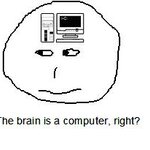Neuroscience

Researchers from North Carolina State University have identified a gene, FoxJ1, that tells embryonic stem cells in the brain when to stop producing neurons. The research is a significant advance in understanding the development of the nervous system, which is essential to addressing conditions such as Parkinson's disease, Alzheimer's disease and other neurological disorders. The bulk of neuron production in the central nervous system takes place before birth, and comes to a halt by birth. But scientists have identified specific regions in the core of the brain that retain stem cells into…

Whether you're a liberal or a libertarian, it's generally accepted across the political spectrum that, in some form, the opportunity to make a lot of money drives the economic recessions and depressions the global economy experiences.
Since we seem doomed to repeat the mistakes that brings us to the brink of economic meltdown every few decades, is there perhaps a scientific explanation for our behavior?
According to a study soon to appear in Cortex, monetary gain, or even the mere possibility of receiving a reward, is known to activate an area of the brain called the striatum, and high-risk…

No one draws pictures of heads with little gears or hydraulics inside any more. The modern conceptualization of the brain is firmly computational. The brain may be wet, squooshy, and easy to serve with an ice cream scooper, but it is nevertheless a computer.
However, there is a rather blaring difficulty with this view, and it is encapsulated in the following question: If our brains are computers, why doesn’t size matter? In the real world of computers, bigger tends to mean smarter. But this is not the case for animals: bigger brains are not generally smarter. Most of the brain size…

Mice who had the PKCI/HINT1 gene removed had an anti-depressant-like and anxiolytic-like effect, say esearchers writing in BMC Neuroscience who applied a battery of behavioral tests to the PKCI/HINT1 knockout animals, concluding that the deleted gene may have an important role in mood regulation.
Elisabeth Barbier and Jia Bei Wang, from the School of Pharmacy at the University of Maryland, USA, carried out the experiments to investigate the role of the gene in regulating mood function. Wang, the corresponding author of the paper, said, "The knockout mice displayed behaviors indicative of…

Enhancing the effects of dopamine influences how people make life choices by affecting expectations of pleasure, according to new research from the UCL Institute of Neurology.
Published today in Current Biology, the study confirms an important role for dopamine in how human expectations are formed and how people make complex decisions. It also contributes to an understanding of how pleasure expectation can go awry, for example in drug addiction.
The study builds on earlier research which used brain imaging as participants imagined holiday destinations. An area of the brain called the…

If you're sore from a strenuous workout or your thumb is pulsating because you hit it with a hammer, look at a pretty picture or listen to your favorite song. It just might help you cope with whatever unpleasant feeling you're experiencing . That's the conclusion of a study published in the Proceedings of the National Academy of Sciences that looked at the connection between human emotions and physical pain.
"Emotions – or mood – can alter how we react to pain since they're interlinked," says lead author Mathieu Roy. "Our tests revealed when pain is perceived by our brain and how that pain…

Boston University Researchers have shown that intermittent access to fatty and sugary foods induces changes in the brain that are comparable to those observed in drug dependence. The findings, reported in the Proceedings of the National Academy of Sciences, may help explain how abstinence from these foods contributes to relapse eating among dieters as well as related eating disorders.
The researchers used 155 rats to measure the neurobiological responses. The first group, the diet cycled subjects, repeatedly ate standard rat chow for five days, followed by a highly palatable, high-sugar…

Everybody has memories they'd like to forget forever. Now, thanks to research conducted by scientists at the Friedrich Miescher Institute for Biomedical Research, there might be a pill for that.
According to their study recently published in Science, it may soon be possible to control fear memories with extinction-based drug therapies.
The Researchers studied proteins in mice known as extracellular matrix chondroitin sulfate proteoglycans and discovered that they form 'neural nets' in the brain which protect against the erasure of fear memories. By giving the mice a drug called…

In a column posted a few days ago (November 1) I mentioned that my friend John Evans, a Cambridge (England) mathematician, has developed a general formula for estimating biocomplexity. It is quite simple, using only two variables: the number of units in a system, and the number of connections (interactions) each unit has with other units in the system. Today, in fact, biologists publish ‘interactomes” with furry ball figures that illustrate the number of proteins in a given cell and the number of interactions each protein has with other proteins. The concept of complex…

John Evans, a mathematician friend of mine in Cambridge England, came up with a formula that specifically allows one to estimate the relative complexity of nervous systems in the animal kingdom, from C. elegans to the human brain. It takes into account not just the number of neurons in the brain, but also the number of synaptic connections that link neurons to one another, and in a second version, the encephalization quotient. In one sense, the formula is simplistic, yet to my knowledge it is the first attempt at such a calculation, so it will be interesting to see if it actually works.
The…